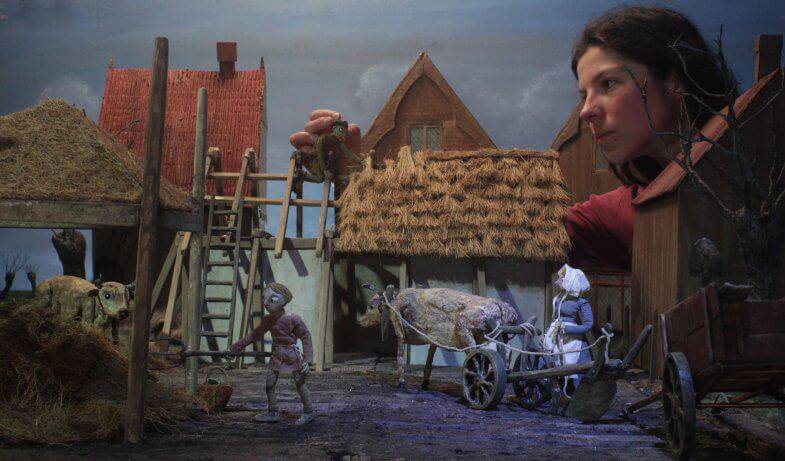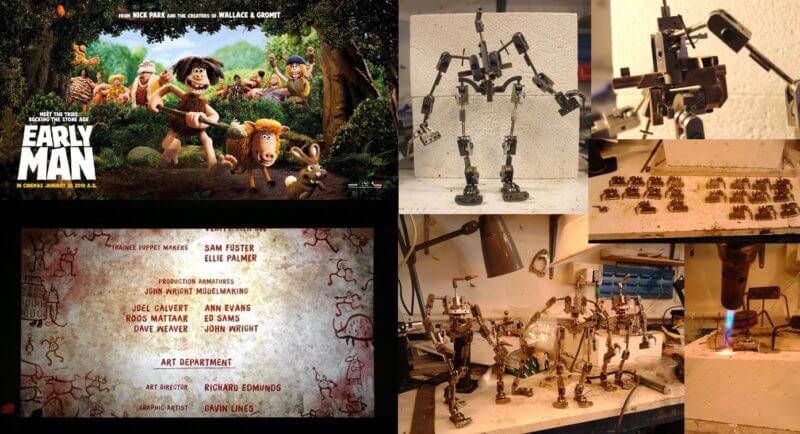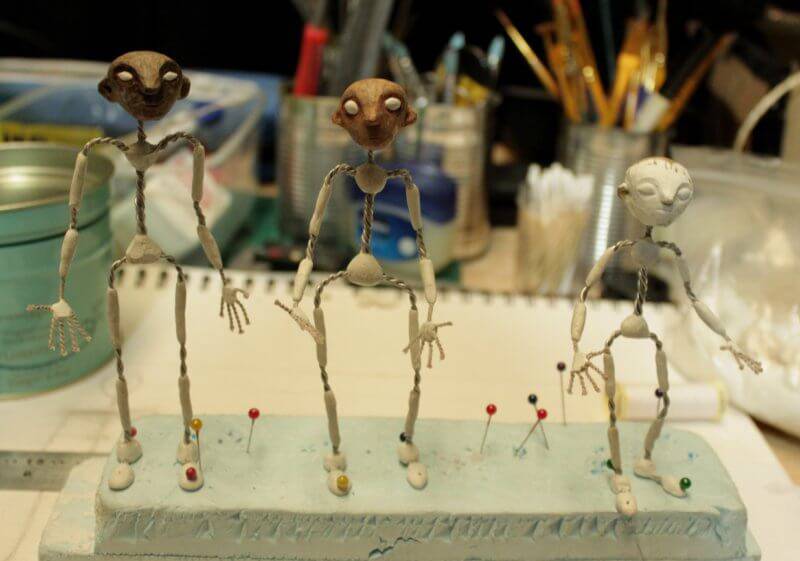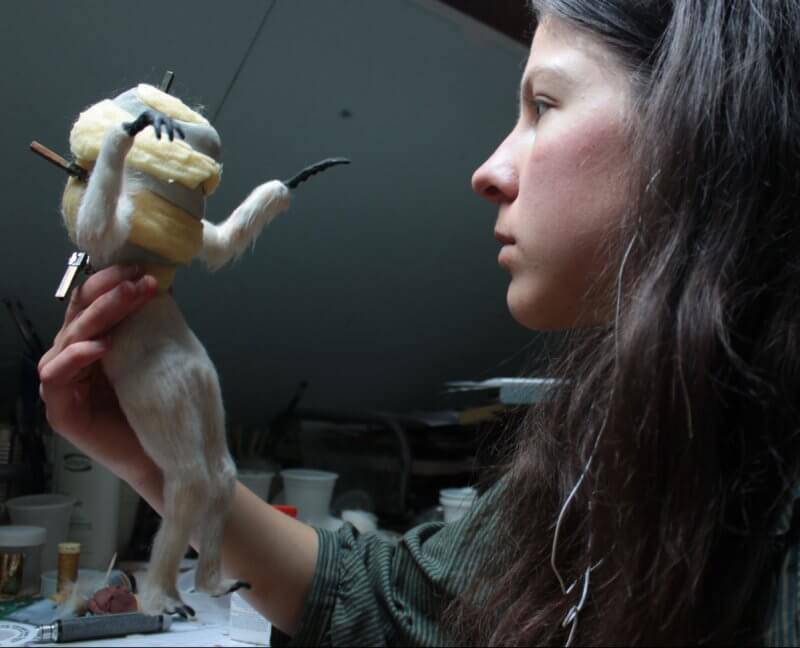Interview with stop-motion artist Roos Mattaar
Since graduating from UWE’s Bristol School of Animation in 2015 with the RTS-winning film Moonbird, Bristol-based Dutch artist Roos Mattaar has fast become a firm staple of the local animation scene with subsequent projects including work on music videos for Father John Misty and Sparks, puppet fabrication for a variety of projects as well as helping to build armatures for projects such as Early Man, Isle of Dogs, Postman Pat and Twirlywoos. In anticipation of an armature building workshop she is leading this weekend at the Stop Motion Academy in Berlin, Skwigly chatted with Roos about her path to animation, her ever-growing body of work and the art of creating effective stop-motion with limited resources.
 What led you to animation – particularly stop motion – to begin with?
What led you to animation – particularly stop motion – to begin with?
I have always been interested in telling stories. As a child I wrote stories and as a teenager I developed an interest in filmmaking. Initially I started out exploring live action filmmaking. I was fascinated by the craftsmanship that went into set, props and miniature building and practical effects in big scale movies but obviously did not have the space and budget for this sort of thing. This is when I discovered stop motion animation and fell in love with it. It meant I could be more ambitious and build bigger worlds, by doing it in a smaller scale. I think it is also the fact that it allowed me to combine a lot of different interests, from storytelling, filmmaking, to making and building things, solving technical problems, etc.
Can you tell us a bit about the production and subsequent reception of your UWE film Moonbird and in what ways that experience has contributed to your skill set and career?
Moonbird was my graduation film from the Bristol School of Animation at UWE in 2014. It has definitely been a defining project for the start of my professional career after university. I built the main character, the metal bird, during my 2nd year on the course. This was my first experience with ball and socket armature making and that on its own has been a huge learning curve and taught me many new skills. The film itself combined animation with live action and I was using a smaller scale for the full attic set so there was a lot of compositing to put everything together in the final film. The film was screened in various festivals and won the Animation RTS West of England Student award. When I was looking for work after graduating I think it was useful that I had some skills in different areas. At the first internship I did at A+C studios, I did some model making for both puppets and sets, but also some animating and some post production. It was a very quiet period for stop motion animation initially and I found some jobs in compositing and editing. Eventually I was offered a trainee position at the armature department at Mackinnon & Saunders in Manchester. I think the fact that I had built the armature for Moonbird from scratch, and learned many metal fabrication skills on the way, was the main reason that I was offered this opportunity and similar for armature work at after this. It is specialised skills which it seems not many people choose to learn in depth, and so if you show an interest and some experience I think it is less competitive than for example working as an animator or sculptor.

Early Man armatures developed with Aardman at John Wright Modelmaking
As well as puppet fabrication for a variety of projects your professional experience includes armature development for feature films. How did you get involved in this and has being involved in such an early and crucial stage of production been useful to you when it comes to animation itself?
I had always been interested in learning more about the technical side of puppet fabrication, and when I had the opportunity to learn about metal fabrication at UWE this got me really excited. I was fascinated about how ball and socket armatures and the more complex mechanism worked and were made. Learning metal fabrication skills wasn’t part of the animation course, but there were facilities and workshops available to students of all the courses. After university I applied to lots of places and different positions, but because of this experience I was offered work specifically in armature making. I have definitely learned loads from these opportunities. I’m not sure if it has specifically been useful to the animation itself. The armature of a puppet is one of the main important tools for stop motion animation though. With most of the recent projects I have been animating puppets that I had also built. That already is useful because I know the puppets well. It also works the other way around: sometimes there are issues with the puppet and some scenes are more difficult to animate because I am fighting the puppet. Sometimes it is a choice I had to make because of budget and time constraints, but often also they are mistakes I can learn from and try to improve next time, remembering what worked and what didn’t.
Since then you’ve worked on music videos, including one for Father John Misty. How did you get involved with Jackknife Films and what was your role on the project?
This was a very last minute opportunity and lucky coincidence that I was able to do it. The producer Rosie had been in touch with Mary Murphy, who was also my ex-tutor in stop motion at UWE. She recommended me as an animator. When I met Chris Hopewell and the rest of the crew at Jacknife they were desperate to find a lead animator for the project as the deadline was only 2.5 weeks away.. There also wasn’t a puppet yet. So I got involved the next day to build an armature and did some of the puppet making over the weekend of the main girl character. She was finished by the other model makers and I was mainly animating after that. In the end more animators joined and we set up an improvised 2nd unit as otherwise it would have been an impossible to get everything done in time.
You were also prominently involved in the making of Edith Piaf, was this a largely similar experience or did it offer up some different/new challenges?
I would say this was quite a different experience again. There was a little bit more time, but a much smaller crew. For the Jacknife video there was a separate DOP, editor, producer, several model makers, etc. in this case it was just Joseph Wallace, me, Aiden Whittam who joined for part of the production period as animator and model maker and a few more people helping out with some of the model making. I was much more involved in all the different aspects of the production process. Joseph was director but also animator, model maker, editor, and we worked on the puppets together. I was doing set dressing and lighting for the scenes I was animating and helped with little bits of post-production. Every project has its own challenges, and this one definitely had plenty of them. I think also when you work closely with a director on projects like this, they have different ways of working and you try to interpret their vision and translate that into what you are making and animating. Joseph had very clear ideas about the look of the puppets but also about the style of the animation. It has been a great project to push my animation skills and I learned a lot from his ways of working in many aspects of production.
Does working on music videos offer any particular creative freedoms or advantages over other types of animation projects (commercials/narrative shorts etc)?
One thing I like about music videos in particular is that the music itself becomes a great guide for the animation. You can really play with the rhythm, feel and intensity of the music in the animation performance. Although this was also a difference between the Father John Misty and the Sparks video: whilst Joseph embraced ‘animating on the music’ and using the beats in the music, Chris didn’t specifically want this, although the steps of the main character’s walk are on the beat of the music. I think story wise music videos also give an interesting freedom. There is generally some sort of story and/or message already in the song itself, but often the director is given a lot of freedom in his/her interpretation. It gives an opportunity to make a little short film in a way, although because the song and music complement the visuals it doesn’t have to be a fully rounded story. It can be a bit more experimental and may have an open ending that wouldn’t have worked on a standalone narrative short.
Are there any professional experiences you’ve had that have directly contributed to your own artistic direction and creative/production process?
Last year I have been really trying to focus on getting back to developing my own creative work as well as seeking out opportunities to pitch for commissions as independent director/animator. The short historical film Nieuwstad was my first opportunity to direct a commissioned short. Although the story requirements and need for some historical accuracy were quite specific I still had creative freedom in how the story was told and in choosing the style and aesthetics. I have also been actively working on writing pitches for opportunities that came up. Recently this lead to being shortlisted and invited to live pitch in Exeter for the South West Documentary commission during their Two Shorts Nights event. Although my pitch didn’t win, I have been given some really useful feedback and new leads to help find other routes to realise this project in the future. I also attended Animarkt in Poland last year, where I was participant in the three day animation workshop by Tim Allen, to try and improve my animation skills. Besides this it was an amazing event to meet people, learn from watching the pitching sessions, talks and just talking with other creatives and learning more about the wider European animation industry. Currently I am working on a music video, which after Nieuwstad feels like a next step to directing a creative piece of work. In this case the band had some ideas about the story and the meaning of the song, but in the end I was really free in my interpretation and creative input.
What were the circumstances behind Nieuwstad coming to be and can you break down the overall production pipeline (if I remember right you took on most if not all of the actual work)?
Nieuwstad was a project about the history of a part of my hometown. It actually started with a local journalist who is also a big fan of the band Sparks, and when he found out about my involvement with the Edith Piaf music video he interviewed me for a regional newspaper. Later during a family visit I went to meet him as well as some of the artists at a new local theatre and arts venue in my hometown. They were working on a project with various events spread over the year to celebrate that the town had existed 700 years (or more specifically, that was the date it received ‘city rights’). They were contemplating a possible animation project as part of this. The funding for this initial idea was not secured but there was another project already running with various short videos as part of a historical walk. Nieuwstad was made as one of these clips, telling the history about a specific location in the historical centre. And yes, I did take on all of the work for this project on my own. I started with conversations over e-mail with the project leader and also at times checking things with a local history expert, to make sure that all the reference images I used to design the sets and the puppet’s costumes would be historically accurate. After making the storyboards I worked on the puppets first and then started building the main props and set pieces. I didn’t finish all of the set building before I started shooting, but rather started putting things in front of the camera and building whatever more I needed as and when I needed it. The sky backdrop was painted on a big canvas, and I later cursed myself for starting out so detailed, as because it needs to look like things are happening and changing over a longer time I had to constantly re-paint it during the shoot. Mostly everything was shot directly in camera, including some forced perspective to make the landscapes look bigger than they actually were. For the final edit I also did the sound design and added the music.

progre
I know that you and other creatives have worked to create a dedicated space for independent stop-motion production, how did that come together and has it been advantageous to your work?
Yes, Hangar Puppet Animation Studio is our new shared studio space and part of the Estate of the Arts in Bristol. Whilst I was working on the Sparks video with Joseph Wallace he had already been talking about wanting to find a bigger space and ideally sharing it with others. I was renting an attic space at that time for my own studio space, which wasn’t ideal but worked for me then. Sometime later this space suddenly became available at a new artist community, Estate of the Arts. I went down to visit it with Joseph, and we were looking for more people to join if we would take it. It was scary and risky to make the decision at that stage to go for it, but it has definitely been very advantageous for my work already. We are now with seven people in total – Joseph Wallace, Katie Hood, Marie Lechevallier, Heather Colbert, Mary Murphy, Marnik Loysen and me. We have been doing a lot of DIY and I learned some new skills from bricklaying to floor levelling and designing and building a wall with doors and windows, in full scale rather than for a miniature set! Now the space has finally been coming together it has just been amazing to have a proper shoot space and a great space for making stuff, and to be sharing it with others is so much more inspiring than hiding away in an attic in the outskirts of Bristol. Nieuwstad was the first project I fully completed at Hangar and I couldn’t have made that in the space I had before. Currently I am working on a music video project in the studio, and being more ambitious again so the spacious units are already starting to feel small..!
While independent animation is experiencing something of a heyday due to the advancement of digital technologies, stop-motion still obviously depends on working in a physical space with physical objects in a very time-consuming manner. Do you have any advice for independent stop-mo filmmakers on how to create appealing work within a feasible timeframe and budget?
I will have to admit that this is still something I am finding challenging myself. I tend to get a bit overly ambitious when I get excited about a project, but yes it is important to find ways to work efficiently and I think part of it is become more experienced after doing some projects and figuring out what is time consuming and what actually works well on camera. It is always important to start testing things out in front of the camera early on, especially when it comes to set building. I now tend to maybe make some key props and pieces in advance, but then start arranging things for the camera to see what works, and so you only make what is necessary, and you can see where you need to add the details. You are building something that needs to look good from a specific angle in a specific composition, not building a piece of work that will be put in a museum. Puppet fabrication is one of the most time consuming parts of stop motion I think, and I have been experimenting a bit lately with projects where the budgets are small. It is about deciding what the best solution for a particular project is. For example, the Nieuwstad project I needed about 80 seconds of animated footage and the puppets didn’t have complicated facial expressions or needed rigging. So a very basic wire armature was sufficient. In other cases for a longer project with a more complex character it might be better to choose for a ball and socket armature but if the budget is limited it might not be realistic to have 5 characters.

Puppet fabrication for Ewa Luczkow’s Moth
This weekend you’ll be presenting a workshop in Berlin, what sort of things will this involve for participants?
The workshop is part of the Stop Motion Academy, with 6 different workshops spread over 2 weeks in two locations in Germany. My workshop is the last one and so far it seems to have been a great success already. The workshop will be three days about stop motion armature making. The participants will be designing and building a custom stop motion armature. The armatures we will be building will be wire, but also learning about silver soldering and other basic metalwork techniques and applying this to more industry standard solutions to feet, tie downs, rigging points and replacement parts. On the final day we will be talking more about ball and socket and working on transferring a wire armature design to a ball and socket design. Most of all though I hope that I can share how all these different approaches to armature making are just a valid and how to choose the best solutions for each project. I hope that I can share a lot of techniques and processes and pass on knowledge and skills that I have found very valuable to learn myself about armature fabrication over the last years.
Do you have any personal or professional projects on the go at the moment that you can discuss?
Currently I am working on a music video for a Bristol based band. Right now I can’t discuss all the details, but it will be released early May. I am having a lot of fun with it and am really trying to experiment with new things. For example I am mixing in some live action special effects, and so there will be a lot of compositing to combine the different elements. In some ways similar as in Moonbird, but it is fully puppet animation. I have also been developing two short films and a short animated documentary. The documentary idea was selected as one of the last five to present in front of a live jury and audience for the South West Documentary Commission 2019, during the Two Short Nights event in Exeter. It didn’t win, but I have received some further helpful feedback from the jury and once I have finished the music video I am planning to revise the pitch and submit it to other funds. The documentary idea is about a strong and intelligent 18th century British woman: Lady Mary Montagu, and her unique relationship with the local Muslim women in Turkey during her stay there. The short film project I am working on is a metaphorical dark fantasy story and is a fantastical interpretation of more personal experiences. I am in touch with two producers and am hoping to get back to this soon so that I can submit it to the BFI short film fund. I have also been involved with an ambitious stop motion short film project ‘Tregeagle’ by Simon Tytherleigh (Odd Planet Studios). I recently animated one scene for the project of which part is used in a trailer. The project is currently awaiting further funding, which if this happens I will be working on as 2nd animator.
Learn more about the work of Roos Mattaar at roosmattaar.com

